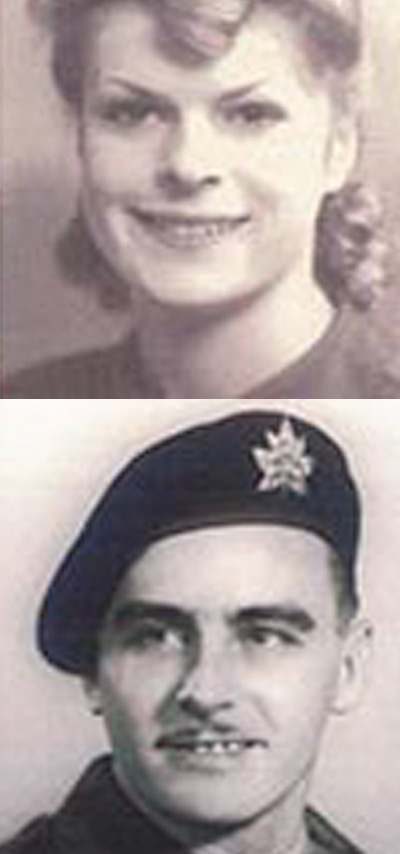
Our veterans
Kenneth & Freda Armstrong
Ken Armstrong exemplified that romantic tradition in which a young man sent overseas to fight for his country finds love in danger, challenge and hardship.
His future wife, Freda, was actively defending her homeland, England, both before and after her marriage to Kenneth. Their story bears witness to the fundamental human impulse to reach out, build up and nurture rather than destroy.
Ken signed up in the Royal Regiment of Canada Infantry just a few weeks shy of his 19th birthday. At a recruiting meeting, a colonel spoke about the war, inviting anyone wishing to go on active service to cross to the other side of the recruiting hall: at least 99% answered the call.
Instead of being sent directly to Europe, Ken found himself on patrol duty in Iceland. There was already a German military presence in Norway, so the defense of Iceland was a tense waiting game. Allied soldiers worked “two weeks on, two weeks off”, armed with machine guns and binoculars to scan the North Atlantic’s frigid waters for signs of German U boats or landing parties. Ken recalls going on patrol in an Icelandic fishing boat used to carry mail, ammunition and whisky to the Royal Navy stationned on the East coast of Iceland.
One day, a German plane flew over the fishing boat carrying Ken and a six-man crew. Although known to be pro-German, the Icelanders were anti-Nazis, so it was a tense moment when the 2-engine Dornier bomber flew over the boat, which, as usual, was sailing under the Icelandic flag. Luckily, all six men were wearing ordinary sailors’ oilskins. Cordial waves were shared, and the German bomber flew away.
However, the fear of invasion was well-founded. While in Iceland, Ken’s unit rounded up German engineers mapping territory for possible airfields.
In November 1940, Ken Armstrong sailed for England on the Empress of Australia. In England, he was transferred to a reconnaissance role with the 4th Cdn. RECCE (Reconnaissance) Squadron. At first, this involved patrolling the South coast of Britain by motorcycle. By 1941, the 4th Cdn. RECCE Squad was amalgamated into the 8th Cdn. Reconnaissance Regiment (14th Hussars) and, for the most part, motorbikes were replaced by armoured cars.
In 1939, Freda Birch-Johnson joined the City of London Civil Defence as a telephonist. She met Ken Armstrong in November 1940 when he was on his first military leave. One night when Freda was on duty during an air raid, a bomb landed just outside the window of the Civil Defence post but did not explode. It was a common practice to drop delayed action bombs, timed to detonate minutes or hours after hitting their target so that rescuers and firefighters would be injured. During this time, the Germans also dropped many incendiary bombs that young girls would run to extinguish.
The romance between Freda and Ken blossomed, and they were married in October 1941. Freda transferred from Civil Defense to the Fire Service, which coordinated civilian response to air raids and other fire emergencies at Tottenham, North London, in the thick of the Blitz. The couple’s son, Kenneth John Armstrong, was born in 1942. At one point, Ken convinced Freda to move with the baby from London to a village not targeted by the bombing. She found it too quiet and returned to her former post while her mother looked after baby Kenneth.
Now with a wife and small child in England, Sgt. Ken was part of the massive Allied invasion of Europe, which started on D-Day, June 6, 1944. Since the armoured cars were no match for the razor wire and other German fortifications, Ken landed at Juno Beach on June 10. The vehicle of choice provided to Ken and the other RECCEs (pronounced “rekkies”) was the Staghound Armoured Car, a cramped, uncomfortable vehicle the Germans called “Tommy Cookers”.
In Normandy, around July 18, 1944, Ken and a comrade, L/Sgt. Hill, were on a RECCE. At a crossroads, he sent Hill’s car off to the left, and he took a right. The last radio message Ken received from L/Sgt. Hill was that he was under fire. Then silence. Later that day, Ken struck a land mine and was evacuated to England. Ken was advised later that Hill and his crew were listed as missing in action.
Meanwhile, back in England, Freda was still on alert with the Fire Service. By that time, the main threat was from unmanned V1 doodlebugs and the V2s that zoomed in at rapid intervals with their explosive charges.
Victory in Europe, on May 8, 1945, meant that Ken and Freda’s life together could begin anew. Ken’s regiment came home to Canada early in 1945. Through a stroke of luck Freda and 2-year-old Kenneth Jr. were able to follow just six weeks later. The young couple settled in a suburb of Toronto; Ken and Freda joined the Reserves, and Ken got his old rank back while Freda served in the paymaster’s office. The Armstrongs later moved to Eastern Ontario, where they spent their final years.
